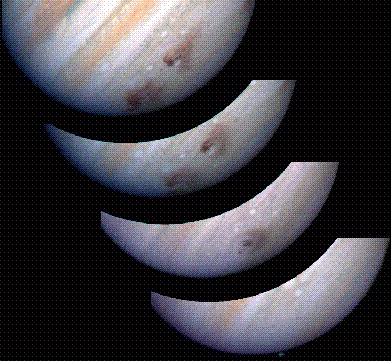
by Ronald P. Millett and John P. Pratt
Reprinted from
Meridian Magazine (14 Jan 2000).
©2000 by Ronald P. Millett and John P. Pratt. All rights Reserved.
Catastrophic event in the solar system opens possibilities of concern for earth.
 |
| 1. Scoffers at Revelation |
| 2. Oceanic Impact |
| Notes |
The Book of Revelation prophesies that a huge burning star named "Wormwood" will fall from heaven, which sounds very much like the collision with Jupiter:
"And the third angel sounded, and there fell a great star from heaven, burning as it were a lamp, and it fell upon the third part of the rivers, and upon the fountains of waters; And the name of the star is called Wormwood: and the third part of the waters became wormwood; and many men died of the waters, because they were made bitter." (Revelation 8:10-11)
Note that the event described in Revelation, while apparently similar to the super event on Jupiter, will be much smaller in magnitude. It does not result in the destruction of all life on earth, but apparently poisons the waters so that "many men" die. Wormwood is a bitter tasting herb which the Lord uses to symbolize the bitter results of sin. For example, "Therefore thus saith the LORD of hosts concerning the prophets; Behold, I will feed them with wormwood, and make them drink the water of gall: for from the prophets of Jerusalem is profaneness gone forth into all the land." (Jeremiah 23:15)
The Book of Mormon is a powerful second witness of the truth of the Book of Revelation. Nephi saw that John would write the Book of Revelation and so it was not necessary for Nephi to record all of his vision of the future himself.
"And I looked and beheld a man, and he was dressed in a white robe.
And the angel said unto me: Behold one of the twelve apostles of the
Lamb. Behold, he shall see and write the remainder of these things;
yea, and also many things which have been. And he shall also write
concerning the end of the world. .... And I, Nephi, heard and bear
record, that the name of the apostle of the Lamb was John, according to
the word of the angel. " (
1 Nephi 14:19-22, 27)
"And also cometh the testimony of the voice of thunderings, and the
voice of lightnings, and the voice of tempests, and the voice of the
waves of the sea heaving themselves beyond their bounds."
(D&C
88:90)
The Prophet Joseph Smith further supported a non-figurative interpretation of the Book of Revelation prophecies in other explanatory comments:
"There will be wars and rumors of wars, signs in the heavens above and on the earth beneath, the sun turned into darkness and the moon to blood, earthquakes in divers places, the seas heaving beyond their bounds; then will appear one grand sign of the Son of Man in heaven. But what will the world do? They will say it is a planet, a comet, etc. But the Son of Man, which will be as the light of the morning cometh out of the east."[4]
Since the collision of the comet Shoemaker-Levy 9 with Jupiter in July of 1994 there have been numerous studies about the possibilities of the collision of large meteors, comets or asteroids with the earth. Since the earth is covered mostly by oceans, the effects of a comet or asteroid falling into the ocean has been studied in detail. One Study indicated that "a 10,000 megaton impact (by a 1-km object) in a 4-km-deep ocean would create devastating tsunamis (tidal waves) over an area the size of the Pacific Ocean"[5] It is interesting that through Joseph Smith the Lord added "the seas heaving beyond their bounds" to the other Biblical signs of the Second Coming.
The violent tsunami resulting from this kind of collision was depicted rather scientifically in the movie "Deep Impact" where a 1.4 km asteroid falls into the ocean off Long Island, New York. Even though this event would be catastrophic for those in nearby low lying areas, such an impact would not mean the end of life on earth. A land impact by a large comet or asteroid, on the other hand, is theorized to much more serious because of the huge amount of dust and debris thrown up into the upper atmosphere.
The Earth bears the scars of many titanic impacts, including a crater beneath Mexico's Yucatan Peninsula, widely believed by scientists to be the smoking gun for the event that snuffed out 70 percent of the species of life, including the dinosaurs. The collision with a comet or asteroid 2 to 10 kilometers across today would have similar global consequences.[6]
It is interesting that one "runner-up" for the Astronomical Event of the Century was very similar. On June 30, 1908, an area of over 2,000 square kilometers of forest in the Tunguska area of Siberian Russia was leveled by an explosive fireball. This blast is believed to have been caused by a small asteroid or comet 60 meters in diameter weighing 100,000 metric tons. After leaving a fiery tail some 800 kilometers long it exploded at an altitude of about 6 kilometers with the energy of about 30 megatons, 600 times the force of the nuclear explosion over Hiroshima.[7]
While many scientists do not yet support the account of many of the catastrophes described in the Bible which were much bigger than the Tunguska collision, such as the Great Deluge, the terrible catastrophes described in the Bible are supported by the testimony of modern prophets. The collision of comet Shoemaker-Levy 9 with Jupiter has triggered serious scientific study of these events that once were considered so rare that we would never see such an event in our lifetimes.